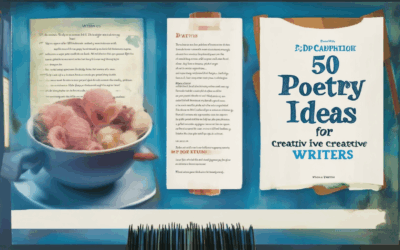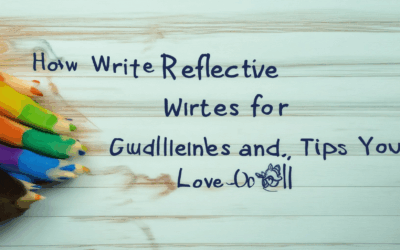The world of poetry offers a unique sanctuary where words transcend mere communication, becoming vessels of introspection and emotion. For those embarking on the journey of reflective poetry, a realm where personal thoughts and feelings take shape, the process can feel both exhilarating and daunting. Reflective poetry, often characterized by its deep connection to the poet’s inner world, serves as a powerful tool for self-discovery and emotional expression. Whether you’re a seasoned poet seeking new dimensions to explore or a novice eager to dip your toes into the waters of poetry, understanding the art of reflective poetry can unlock a whole new layer of creativity and insight.

How to Start Poetry for Beginners
Starting poetry can feel overwhelming, but it doesn’t have to be. Here’s a guide to help you begin your journey:
1. Start Simple
Begin with short poems or free verse. Don’t worry about perfection – focus on expressing your thoughts and feelings. Write about what inspires you, whether it’s a moment in nature, a personal memory, or an emotion you want to capture.
2. Experiment with Forms
Explore different types of poetry, such as sonnets, haiku, or prose poetry. Try free verse to let your creativity flow without traditional constraints. Don’t hesitate to break rules – poetry is about personal expression!
3. Find Inspiration
Read works by established poets to spark your imagination. Poets like Rumi, Mary Oliver, and Pablo Neruda can offer fresh perspectives and inspire unique ideas. Pay attention to rhythm, imagery, and themes that resonate with you.
4. Join a Writing Community
Consider joining local or online poetry workshops or groups. Sharing your work with others can provide valuable feedback and encouragement. Websites like Silken Drum offer platforms to connect with fellow writers and explore creative content.
5. Practice Regularly
Set aside time each day to write. Even five minutes can make a difference. Over time, you’ll develop your own style and grow more comfortable with the poetic form.
6. Attend Workshops
Local poetry workshops can be a great way to learn techniques and meet fellow writers. Many cities offer community centers or libraries hosting regular sessions. Online platforms like Silken Drum also provide virtual opportunities to participate in poetry discussions and events.
7. Share Your Work
Don’t be afraid to share your poetry with others. Reading your work aloud can help you identify areas for improvement, and receiving feedback can guide your growth as a poet.
8. Explore Nature and Emotion
Look for beauty in everyday moments. Observation is key – notice details in nature, people, or objects. Let your senses guide you toward capturing emotions and experiences in words.
9. Keep a Poetry Journal
Write in a notebook or use a digital app to track your progress. Review your past work to see how far you’ve come and to find inspiration for future pieces.
10. Stay Curious
Poetry is a lifelong journey. Stay curious, experiment, and keep exploring different styles and themes. The more you engage with poetry, the more your voice will develop.
Remember, there’s no right or wrong way to write poetry. The most important thing is to let your heart speak through your words. Happy writing! 🌟
Reflection of the Poem
A reflection on a poem is more than just reiterating its content. It involves diving deeper into the poem’s meaning, exploring its themes, and contemplating the emotions or ideas it conveys. Reflecting on a poem allows readers to connect with their own experiences and interpretations, offering a personalized insight into the work.
Purpose of Reflection
- To understand the poem’s themes and messages.
- To explore personal feelings and thoughts evoked by the poem.
- To analyze poetic devices and imagery used by the poet.
- To draw parallels between the poem and real-life situations or emotions.
How to Reflect on a Poem
Reflecting on a poem can be approached in several ways:
- Summarization:** Start by briefly summarizing the poem’s plot, characters, and setting.
- Analysis:** Examine the use of metaphors, similes, and symbols to uncover deeper meanings.
- Personal Connection:** Consider how the poem resonates with your own life experiences or emotions.
- Critical Evaluation:** Assess the poem’s structure, rhythm, and meter, and evaluate its effectiveness in conveying its message.
Example of Reflection
For instance, reflecting on a poem like “The Road Not Taken” by Robert Frost might involve contemplating the decision-making process depicted in the poem and how it relates to your own life choices. This reflection could lead to introspection about uncertainty and the consequences of decisions.
Community and Resources
Platforms like Silken Drum provide spaces for writers and readers to share their reflections and engage in meaningful discussions about poetry. By participating in such communities, you can gain insights and learn from others’ perspectives on various poems.
Conclusion
Ultimately, reflecting on a poem is a dynamic and personal process that enriches your understanding of literature and yourself. Whether through analysis, personal connection, or community engagement, the reflection allows for a deeper appreciation of the artistry behind the words.

How to Teach Poetry for Beginners
Teaching poetry to beginners requires a balance of simplicity and inspiration. Here’s a step-by-step guide to helping new learners embrace the art of poetry:
1. Start with the Basics
Begin by introducing the fundamentals of poetry, such as rhyme, rhythm, and meter. Use simple examples to illustrate these concepts. For instance, explain rhyming couplets or the ABAB rhyme scheme through familiar poems like:
- The Rainbow Fish by Leo Marks (a children’s poem with a simple rhyme scheme)
- Where the Wild Things Are by Maurice Sendak (known for its playful rhythm)
2. Inspire Creativity
Reading great poetry is the first step toward inspiring creativity. Share selections from celebrated poets like William Shakespeare, Robert Frost, or modern poets like Rupi Kaur. Discuss how these poems evoke emotions or tell stories.
Encourage students to imitate what they love. For example, if they admire the imagery in a poem, suggest they try creating their own nature scenes or still lifes using vivid descriptions.
3. Practice Writing Regularly
Set aside time for daily writing exercises. Suggest activities like:
- Writing a poem about a favorite object or memory.
- Describing a scene they imagine in their mind’s eye.
- Exploring a theme they’re passionate about, like love or loss.
4. Provide Feedback Constructively
After students share their work, offer feedback that’s both kind and specific. Highlight what works well and suggest areas for growth. For example:
- If a student writes a heartfelt poem, praise its emotional depth and suggest refining the imagery.
- If their poem has a strong rhyme scheme but lacks rhythm, demonstrate how to adjust the wording for flow.
5. Encourage Collaboration
Form a poetry group or partner students to exchange ideas. They can read each other’s work, offer feedback, and discuss interpretations. This collaborative learning model can make the process less intimidating and more enjoyable.
6. Explore Different Poetic Forms
Introduce various poetic forms like haiku, sonnet, or free verse. Explain the structure and constraints of each form, then let students try their hand at each type. For example:
- A haiku (three-line poem with a 5-7-5 syllable structure) can introduce the concept of brevity and imagery.
- A sonnet (14 lines with a traditional rhyme scheme) can challenge them to master both form and flow.
7. Share Resources
Provide recommended reading lists and online platforms to explore poetry further. Some suggestions include:
- Poetry Foundation – Offers tutorials and resources for all levels.
- Silken Drum – A community-driven platform for writers and poets to share work and get feedback.
- British Council – Features lesson plans and activities for teachers.
8. Celebrate Progress
Acknowledge and celebrate small victories. Let students know it’s okay to struggle and that every poem is a step toward growth. Share your own experiences as a learner to normalize the learning process.
9. Keep It Fun
Make poetry sessions engaging by incorporating games, music, or art. For example, have students create visual art inspired by a poem or participate in a poetry trivia game using famous quotes.
10. Offer Support
Be available to answer questions and provide guidance outside of class time. Encourage students to join writing groups or attend local poetry events to continue their learning journey.
Remember, the goal is to foster a love for poetry and creativity. With patience, practice, and a supportive environment, beginners can develop their skills and find their unique voice in poetry.

What Poetry Should a Beginner Read?
If you’re just starting out with poetry, it can be overwhelming to know where to begin. Here’s a curated list of essential poems and collections that are both accessible and thought-provoking, perfect for building your poetry foundation:### Classic Poems Every Beginner Should Experience1. **”The Road Not Taken” by Robert Frost** A timeless meditation on life’s choices, this poem explores the uncertainty of paths we take and the beauty we might miss.2. **”A Red, Red Rose” by Alfred Tennyson** Part of his “Tenebrae” series, this poem delves into themes of love, loss, and mortality, offering deep emotional resonance.3. **”The Tiger” by William Blake** This powerful poem reflects on self-discovery and the struggle to understand one’s true identity.4. **”Ode to the Lark” by William Wordsworth** A celebration of nature and the joy of creation, this poem captures the essence of simplicity and connection to the natural world.5. **”To Autumn” by John Donne** A lyrical exploration of the season’s changes, this poem invites reflection on impermanence and the cyclical nature of life.### Modern and Contemporary Poets to Explore6. **”Still I Rise” by Maya Angelou** A powerful collection that uplifts and challenges, encouraging resilience and self-worth.7. **”The Tiger” by Rupi Kaur** Known for her intimate and visually descriptive style, Kaur’s work often focuses on personal growth and relationships.8. **”When We Were Young” by Billy Collins** With his conversational tone, Collins creates accessible yet profound poetry that resonates with everyday experiences.9. **”Daddy” by Sylvia Plath** A haunting exploration of grief and identity, this poem is a testament to Plath’s raw emotional power.10. **”Like the Moon” by Langston Hughes** Hughes’ work often touches on themes of freedom and hope, making his poetry both universal and deeply personal.### Collections for a Broad Introduction11. **”The Poetry Anthology” edited by Rita Dove** A comprehensive anthology featuring diverse voices and styles, ideal for exploring a wide range of poetic traditions.12. **”The Essential Poems” by Donald Hall and Ruth Zuckerman** This collection includes foundational works from Shakespeare to Dickinson, offering a solid foundation in English poetry.13. **”The Norton Anthology of Modern Poetry” edited by J.D. McClure** A go-to resource for modern and contemporary poetry, showcasing the evolution of the art form in the 20th century.### Where to Find These Poems- **Online Platforms**: Websites like PoemFlow and The Poetry Society offer curated selections and resources for learners.- **Booksellers**: Stores like The Strand or independent bookstores often have sections dedicated to poetry, with recommendations tailored to newcomers.- **Libraries**: Many public libraries host poetry reading groups and provide access to digital resources.Engaging with these poems and collections will not only enrich your understanding of poetry but also spark curiosity and appreciation for the vast landscape of literary works waiting to be discovered.
The Number One Rule of Poetry
The most essential rule of poetry is to remain true to yourself. Authenticity is the foundation of great poetry. When you write honestly about your experiences, emotions, and perspectives, your work resonates genuinely with readers. Poetry becomes a mirror reflecting your soul, allowing others to connect with your unique voice.
Here’s why this rule is so crucial:
- Honesty Builds Trust: Readers trust authentic voices because they feel genuine emotions coming through. This connection fosters engagement and deeper appreciation for your work.
- Unique Voice Matters: Every poet has a distinct style. By staying true to yourself, you develop a recognizable and valuable voice in the literary world.
- Emotional Impact: Genuine emotion is what moves people. When you write authentically, your words carry weight and inspire others in a profound way.
For example, in Where Have I Failed You by Rainer Maria Rilke, the poet confronts personal failure with raw honesty, creating a powerful reflection on love and loss. Similarly, in The Red Poppy by John Donne, his candor about love and mortality leaves a lasting impression on readers.
To enhance your poetry, consider these tips:
- Write About What Moves You: Choose topics that resonate deeply with you to stay connected to your authenticity.
- Edit Sparingly: Remove anything that feels inauthentic or forced. Keep only what truly reflects your heart and mind.
- Read Widely: Study diverse styles to inspire your own unique approach while staying true to yourself.
Silken Drum encourages you to explore your authentic self and share your poetic journey. Remember, the most impactful poetry often comes from the deepest parts of our souls, offering timeless wisdom and beauty to the world.

How to Start Reading Poetry for Beginners
Starting to read poetry can be an exciting journey, but it’s important to approach it with patience and curiosity. Here’s a guide to help you get started:
1. Begin with Short Poems
Haiku, a traditional Japanese form of short poetry, is an excellent starting point due to its concise nature. These three-line poems often capture moments in time, making them accessible and easy to digest.
2. Explore Different Poetic Forms
There are numerous poetic forms, such as sonnets, free verse, villanelles, and tankas. While sonnets are classic, free verse allows for more personal expression. Experiment with these forms to discover what resonates most with you.
3. Read Aloud
Reading poetry out loud can enhance your understanding of rhythm and meter. Consider recording yourself or joining a group where you can read aloud together. This practice helps in appreciating the musicality of words.
4. Choose Poets Wisely
Start with well-known poets whose works are widely celebrated. Poets like Mary Oliver, Rilke, and Pablo Neruda are known for their accessibility and emotional depth. Look for collections that offer a variety of themes and styles.
5. Break It Down
Take time to savor each line and stanza. Pause where something stands out, whether it’s a vivid image, a powerful emotion, or a clever metaphor. Reflect on how these elements contribute to the overall piece.
6. Find Inspiration
Explore poems that speak to your experiences or spark emotions you recognize. Websites like PoemFinder and The Academy of American Poets can help you discover poems tailored to your interests.
7. Build a Routine
Set aside a few minutes daily to read poetry. Consistency helps establish a habit, allowing you to explore different works over time. Consider keeping a journal to document your thoughts and reactions as you read.
8. Understand the Words
If a poem feels challenging, don’t hesitate to look up unfamiliar words or concepts. Use a dictionary or add notes directly on the poem for clarification. Context often plays a significant role in understanding the author’s intent.
9. Join a Community
Engage with others who share your passion for poetry. Online communities, local poetry groups, or writing workshops provide opportunities to discuss your favorite poems and gain new insights. Platforms like Goodreads can connect you with fellow poetry lovers.
10. Be Patient and Curious
Poetry is a deeply personal experience, and it’s okay to feel unsure or disconnected at times. Keep exploring until you find the poets and styles that resonate most with you. Remember, the goal is to enjoy the journey as much as the destination.
With these tips, you’ll be well on your way to discovering the beauty and depth of poetry. Happy reading!




0 Comments